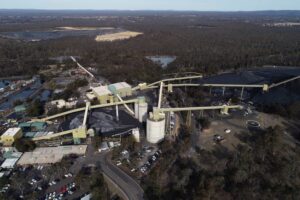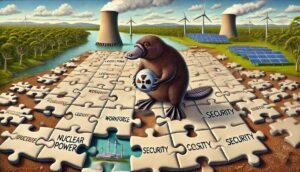Just weeks after slashing subsidies to solar and wind energy, the UK conservative government has signed a deal with Chinese and French state-owned firms to subsidise the construction of the £24 billion ($A50bn) Hinkley Point C nuclear reactor.
It will be the most expensive power plant ever constructed in the world, and the 3.2GW facility has already been dubbed – even by Britain’s conservative press – as possibly the biggest white elephant.

The UK government has offered a guaranteed rate of £92.50/MWh ($A200/MWh) for the output of Hinkley Point C, double the current wholesale energy price in the UK. This price will rise with inflation over the following 35 years to the point where it could reach nearly $500/MWh. It has also offered billions of pounds in loan guarantees.
The deal was finalised during a visit to the UK by Chinese president Xi Jingping – a contract that will see China take a central role in nuclear power in the country, taking a one-third stake in Hinkley C, and then use its own technology to build more reactors elsewhere.
Even pro-nuclear supporters agree that the numbers and the payments are absurd. But without them, the Chinese and French government-owned nuclear companies would not have come to the table, and the reactors would not be built. As it is, some say the investors will make off with £84 billion in revenue.
The Hinkley plant will use the same technology being used by EdF in new plants in Finland and France, both of which have run massively over time, and over budget, sending the development firm Areva, to near bankruptcy.
As the UK decision was announced, the solar industry produced new research showing that solar and storage would require just half the subsidy of Hinkley Point C to deliver the same amount of power over the same lifetime.
The STA calculated that the subsidy needed for Hinkley C would come to £29.7 billion, compared to £14.7 billion for solar and storage – £3.8 billion for the solar element, and £10.9 billion for storage.
It is expected that neither wind nor solar will need additional subsidies post 2020, as costs come down to match fossil fuels. But renewables development has been stopped in its tracks after the Tory government announced plans to quickly phase out subsidies for rooftop solar, large-scale solar parks and onshore wind power.
Three solar companies have already announced their closure, with the loss of 1,000 jobs.
But this is just the tip of the iceberg of the Tory plan since its re-election earlier this year, as it jettisons policies it once claimed its own as part of the “greenest government ever”, in coalition with the Liberal Democrats.
It is also closing the flagship “green deal” scheme that provided incentives to homeowners to invest in insulation for their homes. It has also watered down incentives for electric vehicles, abandoned plans for “zero carbon” homes, approved fracking for gas in nature sites, and wants to sell off its Green Bank.
Former energy minister Ed Davey – a Liberal Democrat – said the Hinkley Point C commitment was “bonkers economics”. Even the conservative Telegraph newspaper described the subsidy as a “national scandal”.
The plant, originally due to go into production in 2017 at a cost of less than £10 billion, will now not be built until 2025 at the earliest, possibly not till 2033, and cost more than twice that much.
The Tories have been accused of double standards, and energy minister Andrea Leadsom revealed the muddled thinking. She said no-one would “advocate an industry that only survives because of a subsidy paid by the bill-payer”. She then went on to describe nuclear as “very expensive” and needing a subsidy of its own.
Davey described the decisions as an “ill-advised and ideologically driven campaign against renewable energy” – but it is one that many would like to see repeated in Australia.

Bjorn Lomborg, the climate “confusionist” who has had proposed funding for an Australian based research centre withdrawn, launched another extraordinary attack against wind and solar in The Australian on Friday.
These sentiments run through the pro-nuclear support networks who, rather than suggesting that nuclear and renewables should co-exist, want renewable energy to be capped at low levels.
A new movement called “Eco Modernists”, which advocates nuclear and downplays renewables, held its UK launch at a right-wing think tank that denies climate science. Their common ideology? A hatred and disrespect of “green” technology.
Indeed, South Australia’s Royal Commission into nuclear energy – proposed by Labor and strongly supported by the Federal Coalition – includes a range of submissions from nuclear lobbyists seeking to limit the extent of renewable energy development in Australia.
The World Nuclear Association, for instance, says Australia’s main energy market “could accommodate … up to 20 large nuclear units of 1000-1300MW each.”
This means force-feeding 26GW of new baseload capacity into a market which already recognises that its current baseload capacity of 26GW (of coal power) is around one-third more than it needs.
The WNA even suggests that some of these plants should be built in South Australia, which has average demand needs of little more than 1GW. Apart from the fact that WNA’s own submission recognises it is a bad idea to have any single plant accounting for more than 10 per cent in a local network, the network upgrade to accommodate this would be phenomenal.
Indeed, the world is moving quickly towards decentralised energy. The UK National Grid – which estimates the cost of back-up power required to protect the grid, should Hinkley C “trip”, at more than $12 billion – says the era of large centralised power stations is coming to an end and the idea of large baseload power stations is “outdated.”
In the US, many major nuclear operators are looking to shut down individual plants, or quit the industry altogether, because their ageing generators can no longer compete in a deregulated market, where prices are pushed down by the falling cost of gas generation and renewables.
Around one-third of nuclear reactors may close because of this, the Wall Street Journal reported, and while several are currently being built, they are all running over budget, and over time, and will likely not be repeated.
The WNA admits that nuclear does not work in a deregulated market, and would require special interventions by the state. It, like other submissions, quotes a paper co-written by Barry Brook, one of the commissioners and a co-author of the Eco-Modernist manifesto, pushing the case for nuclear over renewables.
It is worth noting that the main mining and energy lobbies, including the lobby representing the main coal-fired generators in Australia, have also made submissions supportive of nuclear in Australia.
The Energy Supply Association of Australia, which represents the likes of AGL Energy, Origin Energy and EnergyAustraia, says renewable energy costs are “significantly higher” than nuclear energy. The mining lobby repeats those claims, quoting a study by Brooks’ doctoral student that uses highly inflated costs for solar and wind, and cost estimates for nuclear nearly one-half cheaper than that of Hinkley.
As with the nuclear boosters and the climate skeptics, the nuclear industry and the coal industry make strange but convenient bed-fellows in fighting the growth of renewables, and what they dismiss as the “green blob”.
But renewables – wind and solar – already provide more than 40 per cent of demand in South Australia. Within a few years, they will provide more than 50 per cent, and the arrival of cost-effective battery storage technology will change the economics, and the nature of the grid. That scenario will quickly be repeated elsewhere, if the incumbents don’t get in the way.










